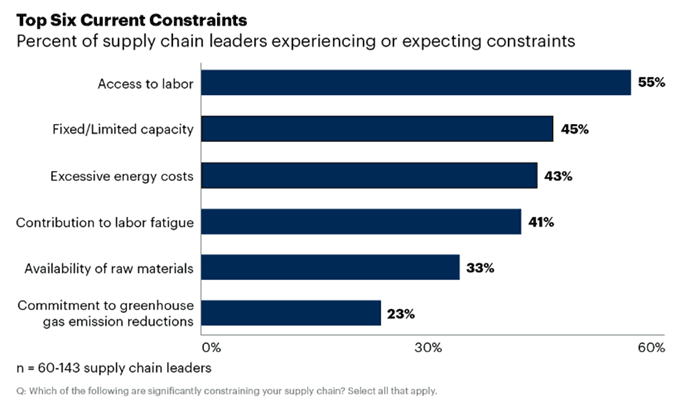Most companies face a series of long-term supply chain constraints, from labor shortages to the need for increased sustainability.
Paradoxically, the best way to address long term challenges is to focus on short term supply chain risks, say the researchers at Gartner.
A press release this week from Gartner summarized a presentation by its analysts recently at the European Gartner Supply Chain Symposium in Barcelona.
That presentation included a summary of Gartner research that found that companies should focus stakeholders on urgent, tangible issues, rather than attempting to mitigate exposure to long-term constraints directly. This approach proves to be more effective in finding solutions to actually address long-term limitations, Gartner says.
The research further found that supply chain leaders can leverage short-term, immediately apparent impacts to business viability to can drive stakeholder buy-in for action longer term.
Gartner cited the top current supply chain resource constraints that threaten business viability, based on a survey of 143 supply chain leaders that was completed in January 2024, as shown in the graphic below.
The Gartner research, presented by Laura Rainier, Senior Director Analyst Gartner’s Supply Chain Practice, noted that “these actions provide a basis for designing solutions that will also address long-term resource constraints (e.g. labor, raw materials, capacity) that are set to be exacerbated by worsening climate change impacts in the years ahead.”
Gartner adds that by centering their strategies on current business viability concerns and de-prioritizing long-term constraints, companies can deliver strong results with even small changes made in the right areas.

Gartner says there are three key categories of action where supply chain leaders should shift their strategies:
1. Motivate Action by De-Prioritizing Long-Term Constraints: Rainier told attendees that it’s especially important for supply chain leaders to focus on generating action through addressing short-term risks that stakeholders are most focused on. Even established long-term strategies are likely to be de-prioritized in the event of supply chain disruptions. In the near term, supply chain leaders should focus on obtaining investments and stakeholder buy-in that address the constraints their organizations are already facing, Gartner says.
(See More Below)
|
CATEGORY SPONSOR: SOFTEON |
|
|
| |
| |
|
|
2. Reprioritize Long-Term Constraints to Design Solutions: Effective supply chain organizations can exert significant influence in product design that can impact considerations from material use to labor efficiency, Gartner says. By engaging with relevant internal and external stakeholders, supply chain leaders can ensure both present and future constraints are considered as part of the design process. They should start with a focus on designing resource constraints out of new products, phasing in more sustainable and viable products for the future.
3. Leverage the Marketplace to Learn and Innovate: Gartner says leading supply chains innovate new solutions by creating opportunities to learn and leveraging their standing as customers to overcome resistance. Further, they rely on external partners to overcome technical and regulatory barriers. Leading companies forge partnerships with innovators, startups and solution providers with a clear goal in mind, using pilots to identify and overcome barriers to that goal.
“It’s difficult to motivate action on long-term constraints when leaders are focused on the clear and present dangers in front of them,” said Rainier, adding that “Rather than wait for a mandate that may never come, supply chain leaders can work with the short-term pressures facing the organization to design solutions today that will address both current and future constraints.”
Any reaction to Gartner's research? Let us know your thoughts at the Feedback section below.
|